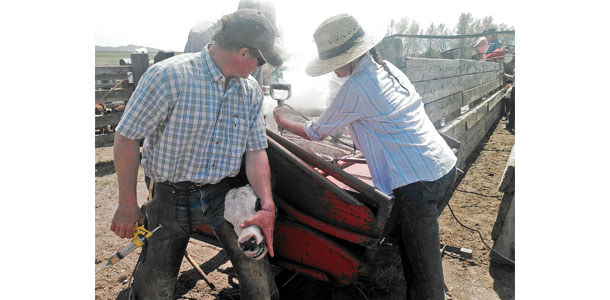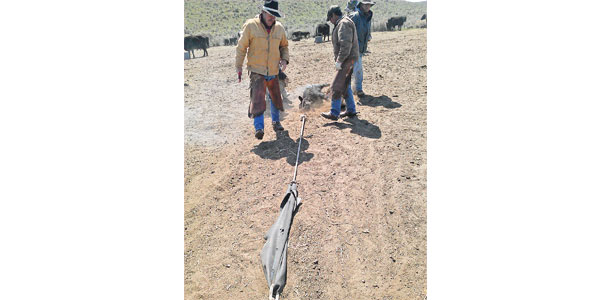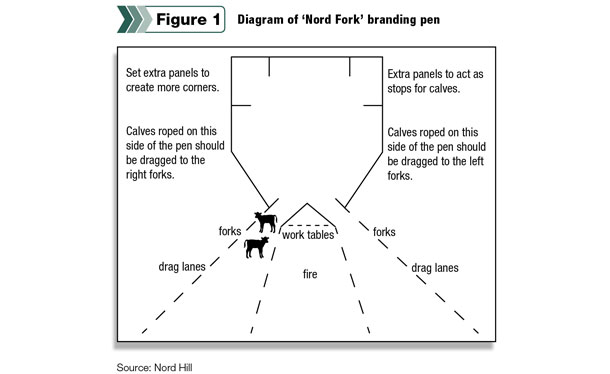While opinions on “proper” may vary, common threads throughout the industry indicate proper handling places the least amount of stress on the animal for the shortest duration possible and with the animal’s best interest at heart to maintain an acceptable level of animal well-being.
By the time you’re reading this, we are well into summer, the spring cattle works are over, and we are thinking about hay crops, checking stock tanks and monitoring forage on summer ranges.
I know everyone’s busy, but we need to look back at the spring cattle works and reflect on any equipment or facility hang-ups that need corrected. The longer we wait, the easier it is to forget them, and when fall comes, we’ll wish we had taken the time now.
The springtime focus in most of the Western states is branding. We take advantage of the opportunity to brand, vaccinate, castrate, de-horn and implant.
While everyone has their favorite method of branding, there are pros and cons to each method that we will analyze. We’ll also look at some equipment and facility designs, highlight some animal-welfare issues and provide some tips to make life less stressful.
When processing calves, keeping the calf still and calm is key to preventing potential injury to calf and crew. Regardless of your method, there is no substitute for a quality crew that keeps the well-being of the cattle as top priority.

Tables and chutes
Using a calf table has its advantages, mainly in the size of the crew needed. There have been many “two-man crews” used to brand a high volume of calves with a table. Some argue that tables are the least stressful method of branding, but generalities should be avoided.
While many tables work well, I have seen tables with more moving parts than a Swiss watch that resulted in injured calves.
Keep in mind when using a table: Alleyways are generally constructed for larger cattle. Narrowing the chute to prevent calves from turning around will increase speed and reduce stress. Some construct a separate facility just for working younger calves.
Branding is often the first real interaction calves have with humans. Make sure the experience is as positive as possible. It is best to place the most relaxed crew member in the pen with the calves.
Cattle sense our attitudes, and the more relaxed the people in the corrals, the more relaxed the calves will be.
Since calves can only be processed one at a time on a table, this person will have ample time to make an impression on your calves, so choose wisely.
If you have a crew member with a personality like a border collie on steroids, put them at the table where they can keep their mind busy with the tasks there.
Make sure the table and facilities are free from jagged edges or anything that could potentially injure a calf. Also, make sure the table can secure calves so they can’t thrash around.
Injuries have resulted from worn-out sloppy tables that can’t safely secure a calf. A properly functioning table offers a great option for those that prefer to work with minimal help, lack the skills or crew that are well-trained in roping methods, or have large calves.
One aspect of tables that makes this option difficult for extensive range operations in the Western states is that cattle must be trailed to a working facility, which is often infeasible and impractical at certain times of the year.
Roping and wrestling
Nothing holds the romantic images of the Old West like a rope-and-wrestle branding. While some see this method as high-stress, it can actually be very low-stress with a competent crew.
It does require a larger crew that is skilled in horsemanship, ranch roping (team roping and rodeo competitions bear little resemblance to how cattle are handled on the ranch) and also cattle handling.
While this is a very common method, many ranchers comment it is difficult to find a crew with the skill set this method requires.
This method does make it is possible to process multiple calves at the same time, allowing for quicker processing as compared to using a table.
If this is your method, again, pick your crew wisely. Only invite those you know have the abilities and mindset you need. Though it is a breach of traditional etiquette to bring an uninvited person to a branding, it happens.
In this case, use your judgment as to how to handle the situation. Perhaps let the person know he or she will not be allowed to participate, or allow them to participate where you can supervise them throughout the day.
If the right crew is available, this may be the most practical method of processing calves, as it requires no permanent facilities. Cattle can be put into a rodear with riders holding the herd; they can be gathered into a fence corner or portable panels to create a makeshift corral to trap and process calves.

Roping and stretching the calf
As noted before, ranchers comment on the difficulty of procuring a competent crew that knows how to humanely and efficiently handle calves.
This has led to ranchers taking labor-reducing measures that still allow the ability to process calves on range without trailing them to permanent facilities.
Many of the progressive and extensive operations today have started using a piece of equipment called the “Nord Fork,” designed originally by Nord Hill of Idaho.
This fork is attached to an inner tube to provide cushioning from tension, which is in turn attached to a stake driven into the ground to secure the fork. It slips over the neck of a calf as it is brought past the fork, safely secures the animal in place and easily comes off when the calf has been processed.
Care must be taken to make sure forks go squarely behind the calf’s head to avoid choking.
Others may simply place the front legs of the calf through a short lariat staked to the ground with an inner tube between the stake and the lariat while allowing a rider to secure the rear legs of the calf. This is commonly called a “dead man.”
The inner tube (a stretchy rope works also) placed between the ground stake and calf is important to allow tension to be held but also some “give,” so as not to harm the calf.
These two options give producers the advantage of being able to utilize less labor than when wrestlers are used and still secure the calf with a low risk of injury to the animal.
This method reduces some labor and allows for processing calves without being obligated to permanent corrals but still requires more people than a table or chute.

While brandings in permanent facilities typically have good, well-planned facilities, brandings out on the range usually occur in temporary pens, and Figure 1 is a good one for making a range branding safe for cattle and crew.
It is efficient and very feasible to set up, as it can easily be constructed with panels or wire traps.
Regardless of how you process calves, key points to remember are:
- Safety of the crew and animals is paramount. Always employ the highest level of stockmanship possible and demand that of your crew.
- Time of day and weather impact animal welfare. Cattle have a hard time dispersing heat and build body heat as the day progresses. Start as early in the day as possible if heat is a concern.
If possible, make access to water available both before and after processing. The USDA ARS has a website (Cattle Heat Stress Forecast) that forecasts the risk of heat stress for your area and is updated daily. - Inspect facilities prior to processing to ensure no safety hazards for the crew or animals exist (rough edges, nails, big rocks, etc).
- Inspect all equipment and replace or repair if needed prior to processing.
- Have your supplies ready beforehand to avoid unnecessary delays.
- Make sure you take all necessary precautions to ensure proper animal well-being through the use of well-maintained equipment and a trained crew.
- When animals are confined in the pens, assess the herd for health, body condition score, and signs of nutritional deficiencies and assess individuals while restrained.
- Have a written protocol and ensure the crew follows it.
- For assistance in developing a processing protocol, contact your local extension office, state extension specialist or vet.

Billy Whitehurst, PAS, is a University of Idaho beef extension educator and co-coordinator of the Idaho Beef Quality Assurance program.
PHOTOS
PHOTO 1: This table allows for safely securing the calf. Note the care taken to hold the calf’s head so that he doesn’t thrash around, reducing potential injury to the calf. Photo courtesy of Brady and Tianna Fife.
PHOTO 2: The inner tube placed between the ground stake and the fork or dead man is vital to allowing for “give” when stretching calves at branding so as not to cause too much pressure on the calf. Photo courtesy of Billy Whitehurst
Figure 1: Diagram of "Nord Fork" branding pen. Diagram courtesy of Nord Hill.
View a slideshow of images related to this article.








